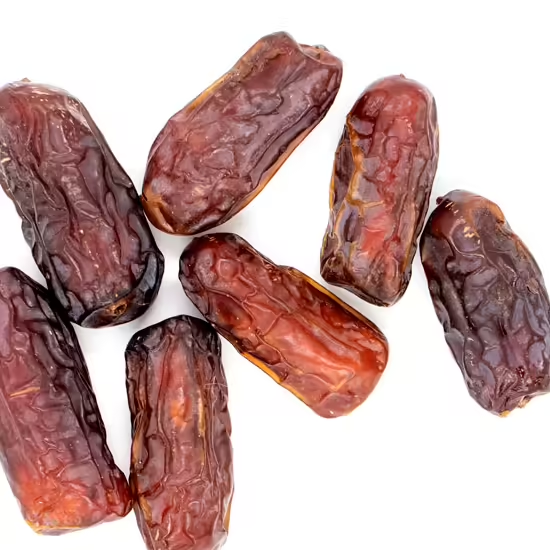Dates
There are several types of dates with different features. Dates are one of the primary fruits in the Middle East and serve as an excellent organic alternative to sugar. They provide a rapid energy boost due to their natural sugars and are high in fiber, aiding digestion and helping prevent constipation. Rich in calcium, phosphorus, magnesium, and potassium, dates support bone strength and heart health.

Zahedi Date
Zahedi date, which is also known as “Ghasab date” in some regions of Iran, belongs to the dry and semi-dry date categories. This date is produced in tropical and southern parts of Iran. The color of this date ranges from yellow to light brown and it’s famous for its great taste. It is the most frequently used dried date. Zahedi Date has less moisture than other kinds of Persian Dates and its moisture is under %14. It is popular for its high quality and nutritional value. The Zahedi Date is a small, round date that is about 3.5 cm.

Sayer Date
Sayer date which is also known as Estameran date is considered as one of the most important export dates of Iran. In the southwest of Iran, Shadegan, there are vast fields dedicated to Sayer date growth. It is considered the main source of income for the local people of Shadegan. Persian Sayer date is well-known among many European countries. The sayer date is semi-dried and has 15- 18% of moisture. This type of date’s color ranges between brown and dark brown.

Mazafati (Kimia) Date
To compare Mazafati (Kimia) dates’ prices in Iran with other date types, it is one of the most expensive varieties available in the market. Renowned globally for its exceptional taste and high quality, Kimia dates boast significant nutritional value, making them a great healthy snack. These dates are categorized based on their moisture content: above 24% humidity and below that, with the moisture level determined by the harvesting time. Harvesting of Iranian Mazafati dates typically begins in early August and continues until the end of October. This type of date is the most common for table eating and snacking in Iran. Fresh Kimia dates range in color from dark brown to black and are graded by sizes and moisture content, such as 700-750 grams, 600-650 grams, and 500-550 grams.

Highlighted Project 4
Rabbi Date
Rabbi date is one of the most popular types of Iranian dates. It falls into the semi-dried category, with a moisture content of 15-16%. This long date boasts a dark brown or dark brown-red color and has a thin skin. Known for its sweet taste, the Iranian Rabbi Date is famous for its delicious and incredible flavor.

Piarom Date
Piarom dates are renowned worldwide for their unique taste and appearance. They are long, slender, and oval with thin skin. Recognized as one of the finest semi-dried dates globally, Piarom dates are primarily grown in the southern parts of Iran, with the harvest season in October. They have lower moisture content (less than 15%) and more flesh compared to other date varieties. The color of Iranian Piarom dates ranges from dark brown to almost black. As a leading Piarom date supplier, we provide the highest quality dates.

Kabkab Date
Kabkab dates are among the most renowned dates in Iran. Initially light brown and burnt brown when in the Rutab stage, they eventually mature into dark brown fruits. Unlike other dates, unripe Kabkab (Kharak) dates have a bitter taste. The oval fruit weighs around 15 grams and features a light yellow semi-dry texture with a thick shell. Kabkab dates are rich in iron and natural sugars, making them a healthy snack. They are also a great source of essential nutrients like calcium, magnesium, potassium, and vitamins A, B, and C.
